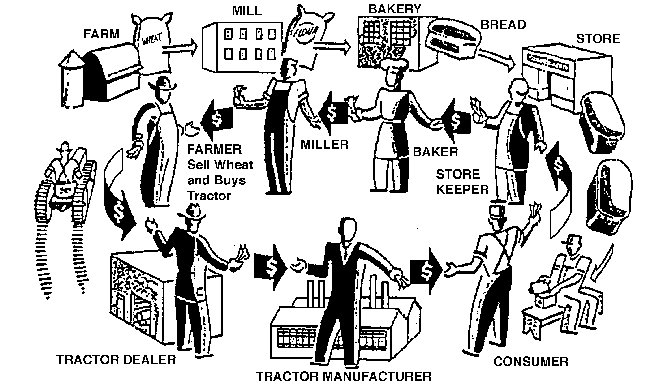

Distribution of Goods, Income, And Services
(NORM Webmaster Note: The World Book Encyclopedia and other standard reference books in recent decades have dropped their definition and description of the DISTRIBUTION CYCLE. The deletion is unfortunate because, educationally-speaking, it prevents students and others from learning how closely their economic well-being is tied to the production, pricing, and distribution of agricultural commodities. To rectify that situation, NORM is posting this article and chart about the DISTRIBUTION CYCLE.) ________________________
DISTRIBUTION is a step in the economic process which brings goods and services from those who make them to those who use them. The making of such goods and services is called PRODUCTION. The use of the goods is called CONSUMPTION.
DISTRIBUTION includes all methods by which the goods are sent from producers to consumers. Another part of this distribution process is the DISTRIBUTION OF INCOME. The distribution of income is the way in which the wealth of the nation is divided among those who produce, those who distribute goods and services, and those who consume goods and use services. Nearly all consumers are also either producers or distributors. Without the process of distribution, people would have no way of obtaining useful services or products, such as food from a farmer, clothing from a tailor, or an automobile from a manufacturer.
DISTRIBUTION OF GOODS: Many steps lie between the making of a product and its delivery to the consumer. Some of the most important steps are transportation, packaging, storage, and advertising.
Methods of distributing goods vary with the particular product and its industry. In colonial times, a shoemaker sold his shoes directly to the consumer, who ordered them before they were made. Today, most of our food, clothing, and other products are made in quantities long before any individual consumer has any thought of buying them. Goods usually go from the producer to the WHOLESALER, who is a person or a company dealing in large quantities of goods.
A WHOLESALER of potatoes buys potatoes from farmers in carload lots. Few grocers could handle such large quantities of potatoes, since they would spoil before they could be sold. The wholesaler sells smaller quantities to RETAILERS. The grocer can buy a dozen sacks of potatoes from the wholesaler's carload and sell them to his customers, who are the CONSUMERS.
STORAGE is another process involved in distribution. Foods and other products which may spoil are stored in cold-storage warehouses. Eggs, meats, seafood, fruits and vegetables are often stored for several months until they can be sold.

THE CIRCLES OF DISTRIBUTION:
Here's a greatly simplified diagram showing how goods, services, and income move from place to place and from person to person.
The OUTER CIRCLE shows how wheat finds its way from the farmer to the workman, who consumes it in the form of bread. The workman helps to produce the tractor used by the farmer in growing wheat.
The INNER CIRCLE shows how the money involved in the various sales and purchases passes from hand to hand.
The NEW WEALTH in the cycle begins with the farmer's wheat, which comes from the soil. The farmer's income, which is a factor of both his bushels of wheat and the price of a bushel of wheat, determines the amount of total amount of earned-income economic activity that happens within the production/distribution circle.
In the 1997 economy, every dollar from the wheat and from
other agricultural commodities generates approximately $9 of business in
the total economy. This is called the TRADE TURN OF AGRICULTURE.
It increases over time as the efficiency of farmers and ranchers improves.
In colonial times, the agricultural trade turn was approximately two.
In the 1940s, it had improved to seven.
Back